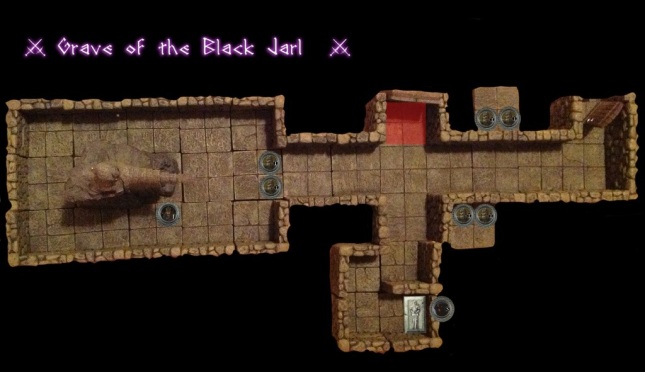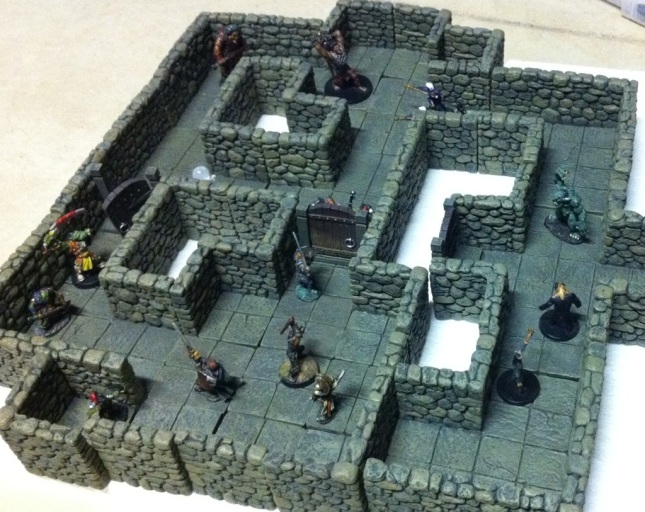
A trusty mount – the hexcrawler’s best friend. Also, a delicious morsel for those 1d4 griffins following you!
A little while ago I sounded the horn for submissions, and they have started rolling in! Not every guest article will fit the usual MO for “Save Vs Weekend” but they’ll all be valuable for you to apply to your games in some direct way.
Our first post comes from a player and sometime DM from my own core group of gamers – guys I have been playing with since high school. He recently ran a short-term “hexcrawl” style game, and wanted to share some of the nuts and bolts of that style of play (A type of game I’m rather enamored of and intrigued by. It has a very “sandbox” world style. Your own little Skyrim at the table!). It was part of a phase we went through in which we tried going “back to basics” and exploring some tenets of the retro-cloned old-school…with mixed results.
____________________________________________________
So, this is my summary for my hexcrawl game. I’m sharing the format with TheYoungKing despite the fact that he played in the game, so he’ll have to feign ignorance if we start it back up again. [He’ll also take the luxury of inserting the occasional comment in these brackets.] The Hexcrawl was a common game type in the 80s; they fell out of fashion but they’re system agnostic, and a blast to run if you’re used to completely plot driven games. In essence, the GM has a map, and you wander around on it. The best example I can think to explain it is Baldur’s Gate. You wander from area to area; there’s an overall theme (in Baldur’s Gate, it’s the Iron Shortage), but the vast majority of your encounters are random, or mini-quests. Here’s the basic outline of how I set up my game.
- I started with a concept; in this case, the players were explorers. Really any type of plot could be factored in, the hexcrawl is much more of a setting than it is anything else.
- I then built a large map in a program called “Hexographer“, from Inkwell Ideas. Each hex is (naturally) 6 sided, with a terrain type; i.e. mountains, plains, ocean, etc.
- Using general principles of geography (i.e. which side of mountains have vegetation, rivers run downhill, etc.), I filled out my map with a few continents.
- Now that I had continents with forests, rivers, and hills, I placed towns appropriately (i.e. near coasts, intersections of major rivers, etc), then supporting villages for those towns (i.e. within a day or two of travel to their “parent” town).
- Now that I had my towns and villages mapped out, I drew borders of countries, based on obvious geographic limitations (i.e., most borders were either on major rivers or mountain ranges).
- So now I’ve got a continent, with countries, and cities. You’ll notice I haven’t named anything yet; this is important.
- In my opinion, the #1 time-waster in world-building is spending time creating content that your players will never see. To that end; I spent 20 minutes brainstorming country names, and placed those randomly. I then zoomed in on 1 particular village in 1 particular country, and named it. This was the seed of my first adventure. I then started mapping (i.e., adding content) for the hexes around that village (i.e. the village was raided by orcs, so traveling in nearby hexes has a risk of… running into orcs!)
- I went to the next closest village. I named it, gave it a few inns, a blacksmith, and a temple. I named the temple and blacksmith, gave a general overview of their services. The inns I populated with rumors. Some of the rumors were false, some were tied to monsters in locations (i.e., there’s a basilisk southwest of here!), some were tied to dungeons (The abandoned barrows are haunted!).
- I then populated the appropriate hex with the basilisk encounter; then wrote a short (5 room) dungeon for the “Dungeon” rumor. From there, I started going to other (i.e. potential choices of my players) villages, and filling them out similarly. At the same time, I started filling out the other hexes in their anticipated route of travel. Were there any monsters they may encounter?
- So, at this point, I’ve got something like 100 hexes mapped with content. Probably 5-10 are villages or towns (towns are basically the same as villages, except they have a few more inns, and maybe a marketplace). I’ve also go 5-10 full on “dungeons”, where I wrote room descriptions, gave them a theme, populated them with monsters, and treasure. Another 5-10 of the hexes are the “encounters” I described, which effectively are just 1 room dungeons, i.e. a location and a challenge.
- So that means of my 100 hexes, 70 or so are just random monsters the player could run into. Since I am mapping these iteratively, I’m able to make it so that the monsters are in similar areas, i.e. if you go to any of the hexes north east of a particular village, there’s a chance you’ll run into some goblins in the area. I don’t really have “random encounter charts”, thus far I’ve only tied 1 type of monster to each hex (just to save myself the work). Odds are, the players either run into that monster or they don’t. The players didn’t complain, because they’d travel enough that they may run into 4-5 different types of monsters in the general area.[The players DID complain when those monsters were manticores…but enough of my sulking…]
- Next steps are to continue filling out towns and villages, which then feed me having to create content based on the rumors I come up with, which leads to more encounters and dungeons.
- To keep track of all of this, each hex has a numeric code, i.e. 71.22. I then have an excel [Or numbers, or GoogleDrive, pick your poison], which I tie to that particular hex information. Hexographer’s Pro version allows you to write notes directly on hexes, so for non-dungeon tiles, I just use that. For my dungeons, I just use excel (GoogleDrive née GoogleDocs would also work).
- I would not have been able to run this game without Hexographer, or the great guide available on the Alexandrian blog.
This type of game can be a lot of work. You can and will create content that your players will never see; the advantage of a plot driven game is that all your great encounters are on the rails, so the players face them no matter what [It’s also not impossible to hold onto some of those good ones and slot them in later. It violates the ethos of the sandbox world a bit – but anything in the name of fun is the right choice]. That said, it can even more rewarding when a trap you set 5 weeks ago comes into play; I’ll give an example.
My players were following up on a rumor that if they caught a fairy to the west of the town they were visiting, it would be forced to grant them one wish. The players outfitted themselves with nets [Do you know how much a cold-iron net costs?! A lot!], jars, and other “fairy-catching” equipment. However, they did not know they were pursuing a *false* rumor; the area to the west was actually lousy with bandits, who had started the rumor in the first place.
It was a while ago that I ran this game, and looking back there are several things I would have changed that would have added more flavor to the game.
First and foremost, I would have come up with some overarching plot. Baldur’s Gate without the iron shortage is rudderless; it also would have allowed me to plan a bit better which direction the players would have headed; instead of having to map in a circle outward, I would have had a better chance of mapping a “path” of hexes the players were likely to go through.
Second, I would have been much more mysterious about what was out there. In my rumors, I named specific monsters the players were likely to encounter; instead, I wish I had said there was a “dark force” or “an unknown evil”, describing what it had done. Keeping the mystery of the unknown is a key portion of any exploration based game.
Finally, I wish I had had more time between sessions. As a result of trying to keep a fairly rapid pace, the quality of my encounters suffered. I am not a great encounter planner, so I am afraid several of my dungeons were rather mundane as a result of having to plan several of them at once in a few weeks time. Getting something right rather than finished I think would have added an extra layer to my campaign. [This is where resources like the One Page Dungeon contest or…ahem…Save Vs Weekend come into play – they can be used to fill in coherent “random” dungeons or encounters to populate a larger world.]
____________________________________________________
I’m of the opinion that 4th ed D&D is a perfectly feasible platform to run a hexcrawl. True, the resource management of 4th ed centering around encounters doesn’t particularly favor a model in which most conflicts occur only once a day, and night’s to rest in between run-ins are frequent. But that requires some slight modification tot he encounter format:
One method is to make travel encounters exclusively of the ‘Hard” and “Very Hard” variety. That way the players are almost always expending their dailies and relying on potions and other consumable resources, giving random encounters a significant impact, event hough the players will likely rest for 8 hours right after.
Another, (and perhaps the more favorable) implementation, is to always make overland travel a simple skill challenge: perhaps calling for rolls with every hex traveled. The particulars are up to the DM and various published adventures might have some insight, but generally calling for Endurance checks for each day travelled, and consuming healing surges when those checks fail (and allowing a small number of healing surges to be replenished while traveling overland) could easily create a resource tension in travel without requiring much tweaking of the original game. It stands to reason that resting on the hard ground in a chilly tent after 7 hours of forced march and resting in a soft, warm inn bed after strolling around town or slowly creeping through a dungeon would provide different levels of physical replenishment.
TL:DR – The hexcrawl…try it!



